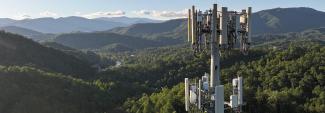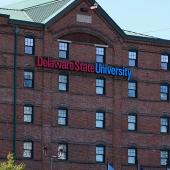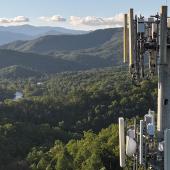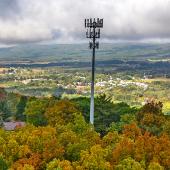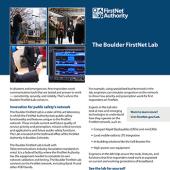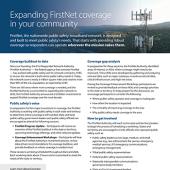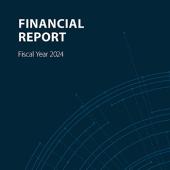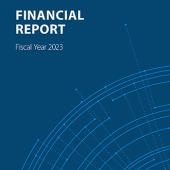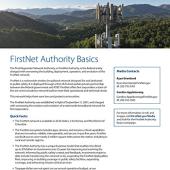Summary
In the latest episode of the Public Safety First podcast, guest host and First Responder Network Authority, Director of Field Operations (Northcentral Region) Lesia Dickson is joined by officials from Texas City (Tx.) to discuss their “whole of community” approach to emergency communications and the use of FirstNet to enhance school safety efforts.
Guest
Lesia Dickson
FirstNet Authority Director of Field Operations for the North-Central Region
Tom Munoz
Emergency Management Coordinator and Homeland Security Director for Texas City
Robert Turner
Information Technology Director for Texas City
Mike Matranga
Executive Director of Security for Texas City Independent School District
Transcript
Preview
Narrator: You're listening to Public Safety First, a podcast to help you learn about the First Responder Network Authority and how you can be part of the future of public safety technology. And now, your host.
Narrator: You're listening to Public Safety First, a podcast to help you learn about the First Responder Network Authority and how you can be part of the future of public safety technology. And now, your host.
Lesia Dickson: I’m Lesia Dickson, Director of Field Operations for FirstNet North-Central region, and I lead the emergency management focus within FirstNet, and today I’m here in Texas City, Texas with Tom Munoz, the Emergency Management Coordinator and Homeland Security Director for the City of Texas City. Also, with Robert Turner, Information Technology Director for the City of Texas City, and Mike Matranga, the Executive Director of Security for the Texas City Independent School District. Texas City has adopted FirstNet across a wide range of departments and functions in order to assure a coordinated communications response in both disasters as well as everyday operations. And so we wanted to talk to them today about how this broad communications strategy is impacting response and impacting the safety and wellbeing of the citizens of Texas City and certainly the school system. So thank you gentlemen for joining me today.
Just to get started – Can I get each of you to introduce yourself and give a quick overview of your role in public safety here in Texas City? And Tom, we’ll start with you.
Tom Munoz: Yeah, good morning. Tom Munoz, as you stated. I am the Emergency Manager, Homeland Security Director to the City of Texas City. You know, in a nutshell, it is my responsibility to ensure the safety of this city not only through natural disasters, but manmade disasters, such as the plants that we have, the chemical plants here and so forth. And just recently, I retired from the Coast Guard, so that was another emergency management piece that I managed. My last activation was Puerto Rico, so as a commander out there, so I got to see a lot. So the responsibilities were basically the same, but different arenas for sure.
Lesia Dickson: Thank you. Robert, you want to introduce yourself?
Robert Turner: I’m Robert Turner, Information Technology Director for the City of Texas City. November will make five years for me here. My role: run the technology, and make sure the lights stay on. Support Tom Munoz in what he can and interface with other departments as they need us – provide options, technology, and things of that nature, so.
Lesia Dickson: Great, great. Well, thank you. And Mike, can you introduce yourself?
Mike Matranga: Sure. Mike Matranga. I’m the Executive Director of Security and School Safety for Texas City, ISD. Texas City has a very unique, has a very unique and diverse population – everything from a higher socioeconomic status to the lowest of socioeconomic statuses. We’ve got 14 schools. We’re in the process of building four new schools and we have roughly 9,200 kids that we support here in the District, and it’s my job to coordinate with our staff, our students, and our parents, emergency operations and school safety and security. Everything from integrated security systems with access controls to some of our new analytic cameras that we’re installing, and to develop systems that allow for mass notification using complex communications.
Lesia Dickson: That’s great. I want to talk to you about all of those. So, tell a little bit more about – Texas City itself. Tell me a little bit more about the size and scope, and some of the risks that you guys face.
Tom Munoz: Well, as Mike mentioned, and Robert mentioned, we have a very unique city and the fact that we do have 19 plants industry-wise, that in the risk model, you know, they vary from the top five products on the Department of Homeland Security list, which is also a concern of chemical release, and then on top of the floods and hurricanes that we’re dealt with. So, it’s, once again, it is very unique – population wise, you’re looking at about 50,000. However, the uniqueness comes with the fact that, you know, those– that industry is embedded, it’s part of our community. And so, it’s not like it’s a separation, you know. Something happens within those plants, and we have to communicate with people, it’s very important and a failure to communication can result in some catastrophic results.
Lesia Dickson: Absolutely.
Mike Matranga: Can I add on to that?
Lesia Dickson: Sure!
Mike Matranga: So, you know, we talk about the uniqueness of Texas City and how we work together. I think that there’s something’s very special that we have here. Being the Executive Director of Security for the schools, everybody’s main focus right now is on active shooters. Well, that is a large part of what we do, but like Tom said, what makes us unique is we have a very large industry here, that is the fabric of our society here, that Tom and I have to also worry about, where other districts or other cities don’t have that combination of the school security aspect and the industry. And so, you know, we have to make sure that all of our bases are covered, both on, you know, the human side regarding shootings and those types of dangers that may pose, and then we have to worry about the industrial complex as well. So, it’s important that we all understand that we are all on the same team. Though we have different titles, we have different employers – whether it be the City of Texas City or Texas City ISD – we’re all the same team. And I think that that’s the key in any type of emergency management or communications plan moving forward is that, everybody has to be communicating and if you can’t communicate well because your system doesn’t work, then you have issues.
Lesia Dickson: Absolutely.
Mike Matranga: Regardless of how much training you have, it doesn’t matter.
Lesia Dickson: Well, well said, and I know whole community has been a big “buzz word” for the past, 10 years, probably. But, you know, that whole community, it encompasses the private sector, the families, the businesses, the whole thing. Robert, I know that you guys have implemented FirstNet across a wider range of departments than I’ve seen in a lot of areas. Who all today is on FirstNet within the city?
Robert Turner: Right now, we have finished moving the police department over to FirstNet completely. The fire department is in the process of making that transition. Our public works department has also started to explore using FirstNet for their SCADA systems, for push-to-talk capabilities. Our water department and sewer department are currently using that as we speak now. So, you know, our public works department’s probably the biggest department we have in the city, so there’s a lot of use there.
Lesia Dickson: Wow. That’s a lot of – you think, then of course, you’re coordinating it through the IT department. What role does the information technology department play in the process?
Robert Turner: Our biggest part is probably evaluation of the product. One of the first things we did when FirstNet came out, was we spent about two days, driving within our city limits, testing speed test, signal test, call quality, things of that nature – just vetting it to make sure it would work and then we look at the technologies that our departments currently have and how we can improve them, how we can make the employee’s life better.
Lesia Dickson: Good. And FirstNet must have tested out well in the coverage for your region?
Robert Turner: Greatly. You beat out a lot of other companies.
Lesia Dickson. Good. I feel like that our plan with FirstNet is really taking shape as far as the buildout, so good that you guys have already gotten it here. If I could just get you to rate, from one to five, your experience with FirstNet so far, with one being the lowest and five the highest, what would you rate it?
Robert Turner: So far, I’d say we’ve had a good strong five. It’s – anything that we’ve had to ask for, any kind of trouble, you know, it’s been a resolution quickly found – never had any issues.
Lesia Dickson: Great, great. now Mike, you have also decided to go with FirstNet at the school system. So, how did y’all make that choice?
Mike Matranga: When I got here, you know like I said, I realized, coming from the background that I come from – I’m a former Secret Service agent, Presidential Counter Assault and presidential detail – I realize the importance of communications. We’ve been in certain areas overseas where the only lifeline we really had was our communications devices. And though we didn’t have FirstNet, we had a similar system, and that gave me piece of mind, knowing that I did have that security blanket. In the event something happened, I was going to be able to reach out to someone. And so, when I got here, we have a great partnership with the Galveston County 911 district, and they do a great job, but one of the things that I did when I first got here was I evaluated the communications after Santa Fe. And after talking to Rob and after talking to Tom and Joe Byrd, who was in Rob’s position, who works for me now, they all responded to Santa Fe and one of the takeaways – the biggest takeaway was that communications was terrible. Nobody was communicating, because they couldn’t communicate, they couldn’t get out, the network was down. And so, having something as traumatic as that in our community already, I didn’t want our first responders to have to feel that sense of desperation again. So, what I did, is I started asking, ‘Okay, is there something similar to the system that I had when we were with the Secret Service?’ And FirstNet came on board and I learned a little bit more about FirstNet and I feel very comfortable with the product. And so, you know, I was able to make the determination on my own to go with FirstNet, and I think that it’s been a great decision. We look forward to the future partnership and growing with you guys. And I know that it makes our deputies, well Galveston County deputies, but they work for the District, it makes them feel like at ease knowing that they have a product that’s going to be able to work in a time of need, always. So, but you know, but we took it a step further and what I wanted to do is I wanted to be able to communicate at a moment’s notice with all of our administrators, not just our police that work with us. So, all of our administrators also have the FirstNet Sonim XP8 phones, and so, you know, perfect example – we had an issue – I want to say it was in early September, we had our very first false alarm of an active shooter. We use a pretty good system through a company called Mutualink and it’s a Rave app, and Rave is the company that they partner with, and it has the ability to notify people, or send out a mass notification that there’s an active shooter, or fire, or emergency medical, or staff assist, or whatnot. So, we had our first false alarm and within you know, a minute and a half, we had seven deputies on scene, because of the quick response and the effectiveness of FirstNet. And once we arrived on scene, we knew that this was a false alarm, so within a matter of two or three minutes, I was able to take what could’ve possibly been our worst day to back down to a normal level and to let everyone breathe and kind of regroup. So, within a matter of three or four minutes, we went from the highest of highs to the lowest of lows because I was able to get on the FirstNet phone, talk to my administrators throughout the entire district and bring everything right back down to normal within a matter of minutes.
Lesia Dickson: That’s awesome. That’s really what we want to see happen.
Mike Matranga: Yeah. So, it was great. I mean, we have talk groups set up and the talk-group function is amazing. I can talk to just my SLOs, I can talk to just the administrators, or I can talk to other specialty groups, but I do have a function on my phone that I can talk to everybody that’s on FirstNet and tell them ‘Hey, stand down or ramp up’ and so that’s how we were able to kind of calm that situation so fast, is I got on that talk group, I went over the air, ‘False alarm, stand down; false alarm, stand down’. Within a matter of minutes, it was right back to normal. All the schools were back to normal operations and it worked beautifully.
Lesia Dickson: So that’s the Rave app, but I know there’s also the EPTT that some departments are using. So this is two separate apps?
Mike Matranga: Well I use the EPT – EPTT to communicate to all the administrators.
Lesia Dickson: Oh okay. Okay.
Mike Matranga: Yeah.
Lesia Dickson: Okay, great.
Mike Matragana: Initially, I was a little upset that there was an accident. But, you know, when I sat back and I looked at – I always look at everything well, ‘Was there any type of learning, you know, involved with that’? And so, of course, I stepped back and said, ‘You know what? Take a deep breath. This is actually a good test for us.’ You know, it wasn’t pre-staged, we didn’t know about it. And we responded well and we were able to communicate, we were able to put it to bed as fast as it went up, it came right back down. And that was using the EPTT function through FirstNet. I was able to communicate across not only law enforcement lines, but administrative lines, and put everything to rest.
Lesia Dickson: That’s amazing. How did y’all evaluate EPTT? Did y’all – were you involved in that together or independently or how did that kind of come about?
Robert Turner: We evaluated it just for just clean communication between ourselves and you know that, to add on to Mike’s incident there, you know, that was one of the quick responses is Joe Byrd, you know, the EPTT works across organizations, so Joe actually notified us like, ‘Hey man. It’s a false alarm so you guys can slow the roll,’ so it has its usage.
Lesia Dickson: Okay, good, good.
Mike Matranga: We were the first district to go with FirstNet in the state, but –
Lesia Dickson: I didn’t know that.
Mike Matranga: Yeah we were. And I didn’t even know until after we had decided to go with FirstNet that they were even considering…
Robert Turner: Which, I’ll say, going back to Santa Fe, you know, we were actually in the process of testing FirstNet when Santa Fe happened. So, when Tom and myself arrived onsite, we had FirstNet devices. We were one of the few people actually able to communicate because of that.
Lesia Dickson: So you’ve actually had the opportunity to see the congestion-management aspect of FirstNet. I know that –
Robert Turner: Oh greatly, we had people next to us getting busy tone, they couldn’t make a phone call and we were acting like nothing in the world was wrong.
Lesia Dickson: That’s great.
Tom Munoz: And not to mention the service. I mean you know, the fact that AT&T was there and we were able to ask for the COWs and they were up there and running and you know, so, the deployment was quite efficient and you know –
Robert Turner: Oh yeah, we- when we called our FirstNet rep, and said ‘Hey look, we have a situation. We need coverage. We need capacity,’ it was within minutes. They even brought down some iPads for us to use temporarily. I mean, there was no questions, there were no concerns. It was, ‘How can we help you?’
Lesia Dickson: We love to hear that – that’s, that’s excellent.
Mike Matranga: I will say, when we rolled out our system to our administrators and our SLOs prior to the school year, you know, I could not have been happier with the service that we received. It truly was a white glove rollout, and it made us feel special, like they really appreciated our business and our decision. So, I’ve had nothing but good things to say about FirstNet and AT&T. You know, one of the things that Tom touched on a little bit was during Santa Fe, the deployment of a COW. And one of the things that I did before I made the final decision to go with FirstNet, was I did contact other providers and we were discussing you know, the rollout of COWs in the event that we had an emergency and some of the prices that I received, and quotes that I received to just deploy a single COW were just incredible. You know, and I recall speaking to a very large provider who had quoted me upwards to $100,000 to deploy a COW in the event we had an emergency. And so that was one of the other sticking points and selling points with me with FirstNet is: they have the same capabilities, if not a better capability, and you know, the COWs would be deployed at no extra cost – it was included in the price. And you know, in the time of crisis, though we’re not really sitting back counting beans, but you know, in the end, it makes a difference and it shows you that it’s – or it shows people like myself, and Tom and Rob, that it’s not about the money. It’s truly about saving lives, it’s truly about being able to communicate and getting people the help that they need.
Tom Munoz: I got to echo that. I think I’m very blessed to have the type of teamwork that sometimes might be unique in some other areas. But, in meeting with the FirstNet representative, one thing that struck me is that they don’t tell me what I want to hear, they tell me what I have to hear. And that makes a big difference in our world and I’ll tell you why – because I have to rely on those things ultimately. And so I think that component has been met with – there is a responsibility that they take and there’s also the accountability that they take very serious. I know, you know, Robert’s always on the phone – if there’s even just a question, there’s not, you actually have a person that you’re talking to, not ‘dial 1 for this, dial 2 for that.’
Robert Turner: Tell you a bit of my piece – it’s short. Before you actually take up the technology, take the time to do a true review. Don’t just sit in your office with the phone and play with it and go home and play with it. That was one of our biggest things. Drive your entire district, make sure it actually works. Go into a couple of the schools, make sure it works. Go into a couple of buildings like ATV or something, and make sure it works. That was our biggest thing.
Lesia Dickson: That’s a good point. What about you, Tom?
Tom Munoz: I think I have to echo what Robert says, but I think from the emergency management standpoint is, understanding the product and knowing what your objectives are. You know, the communications piece, but at the same token, get the experts in the room that know that product. Building that relationship with your – I don’t like to use the word vendor ‘cause I think at this point, it becomes a part of your team – like we do have here, you know, on first name basis. So, I think understanding who you’re going to be working with, getting to know that product, making sure you get the support that’s needed, do your research. ‘Cause at the end of the day that is that product that is going to make life-saving a lot easier for you.
Mike Matranga: I think from my perspective, you know, I like to use imagery. I would say, I would tell that person that was considering it to picture the worst day that they could possibly have – a Parkland, a Santa Fe, a Columbine, or whatever – and you’re there to make decisions and your communications, which is the most important aspect of the whole pie, isn’t working. Now, picture the ability to have that communications piece and know that it’s going to work, and know that you’re going to effectively be able to get assets there, and you could potentially save lives – the next question would be: ‘Can you afford not to do this?’ And I think that when people stop and really think about that, that puts things into perspective. That would be my advice to them.
Lesia Dickson: Well, I can’t tell you how much I appreciate this. This has been, really a great conversation and one that you know, we need to hear. We need this kind of, not only just your experience with the service, but also your experience just with incidents and talking through how communications is important. So, I really do appreciate it. I hope you’ll let me come back in a few months and ask more questions because we’re going to formulate some ideas and then we’ll be coming – you know, feedback loop.
Mike Matranga: How we build a better product for all of us.
Lesia Dickson: Absolutely.
Narrator: Thanks for listening today. We're excited to have you join our podcast community. Make sure to subscribe on iTunes, SoundCloud, and YouTube. You can learn more about the First Responder Network Authority at FirstNet.gov and learn about FirstNet products and services at FirstNet.com.






